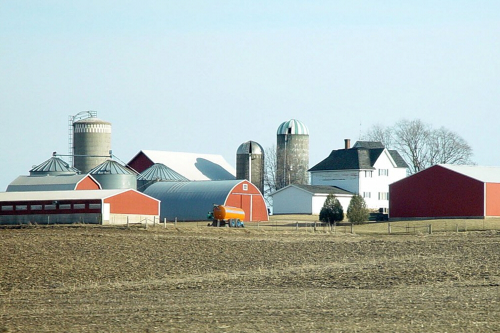Chinese Farmers Have Been Capturing a Potent Greenhouse Gas for Decades
沼气池:中国农村的绿色贡献
Millions of farmers use anaerobic digesters to capture methane from manure, which has also improved indoor air by reducing wood burning
过去数十年来,中国农村利用厌氧沼气池从粪便中捕获甲烷,改善室内空气质量,并向国外推广先进经验
Spreading manure on crops recycles the nutrients, but as it decomposes it releases methane. And lots of it. Agriculture is the largest source of methane emissions globally. Each year, methane from livestock manure has the warming equivalent of 240 million tons of carbon dioxide, or the same as a year of emissions from 52 million cars.
给农作物施粪肥有助于营养物质循环,但粪肥分解会释放大量甲烷。农业是全球最大的甲烷排放源。每年来自牲畜粪便的甲烷造成的温室效应与2.4亿吨二氧化碳,或者5200万辆汽车的年排放量相当。
One of the most effective ways of mitigating this powerful greenhouse gas is to capture it and burn it as natural gas. The Chinese government has been incentivising farmers to do this for decades and the US has too, albeit less successfully.
要减少这种强大的温室气体的影响,最有效的一个方法就是将其捕获并像使用天然气那样将它燃烧掉。数十年来,中国政府一直在鼓励农民这么做,美国也有此类措施,但并不太成功。
In the US, nearly half of the methane released from manure comes from pig farms. Compared to China, the US has viewed methane capture as a low priority and is way behind on adopting it in agriculture. Only 3% of US dairy and pig farms operate anaerobic digesters to capture methane.
在美国,动物粪便排放的甲烷近一半来自养猪场。与中国相比,美国不太重视甲烷捕获,且农业领域这项举措的普及率也远落后于中国。美国仅3%的奶牛场和养猪场使用厌氧沼气池来捕获甲烷。
Responding to energy crises
应对能源危机
The oil crisis of 1979 was a wake-up call for US policy makers. Oil prices shot up threefold, creating gas shortages and long lines at filling stations. Support for alternative energy research peaked in the early 1980s but quickly disappeared as oil prices dropped back to pre-crisis levels.
1979年的石油危机给美国政策制定者敲响了警钟。油价飙升三倍,汽油短缺,加油站前排起了长队。对替代能源研究的支持在上世纪80年代初达到顶峰,但随着油价回落至危机前的水平,这种支持很快就消失了。
In the US, agricultural universities started conducting research and constructed about 140 farm digesters. Sadly, by the mid-1980s, 85% of the early US digesters were abandoned when fuel prices dropped. Farmers went back to storing and spreading untreated manure that continued to release methane into the atmosphere.
美国的农业院校开始研究并修建了约140个农场沼气池。遗憾的是,到80年代中期,由于燃料价格下降,美国早期修建的这些沼气池有85%被废弃。农民又回到过去的老做法,粪便未经处理就储存和播撒,导致甲烷持续进入大气。
Around the same period, China was facing another type of energy crisis – firewood. In the countryside, peasants gathered wood to fuel their stoves, devastating the nation’s forests and creating a health crisis. A research effort funded by the central government was mounted to find an alternative fuel that would allow for the preparation of three meals per day and limit harmful smoke. Methane captured from the breakdown of manure looked promising.
大约同一时期,中国正面临另一种能源危机——木柴短缺。农村地区,农民收集木柴给炉灶烧火,导致森林遭到破坏,也带来糟糕的室内空气质量。中央政府加大科研投入力度,目的就是寻找既能满足农民制作一日三餐的需求,又能降低污染的替代燃料。捕获粪便分解过程中释放的甲烷似乎很有前途。
In 1979, the Ministry of Agriculture created the Biogas Institute in Chengdu, in the country’s agricultural heartland. Researchers there helped develop low-cost, cement-and-brick fixed dome digesters. Research and demonstration projects took off and by 1983 China had seven million rural homes (about 3.5%) operating anaerobic digesters.
1979年,农业部在成都成立了沼气科学研究所。研究人员帮助开发了以水泥和砖块为材料的低成本固定圆顶沼气池。研究和示范项目纷纷启动。到1983年,中国已有700万户农村家庭(约3.5%)用上了厌氧沼气池。
The Chinese Biogas Institute continued to build its programme and in 1981 established the Asia-Pacific Training Center to teach tradesmen how to construct and maintain the small brick digesters. Through the years, this training centre has reached 55 countries, making China a rural biogas technology transfer leader in the Indo-China region.
沼气科学研究所不断开展项目,并于1981年成立了亚太区域沼气研究与培训中心,负责承办中国商务部的援外培训项目,教授他们如何建造和维护小型砖结构沼气池。多年来,这个培训中心已经与55个国家建立了联系,中国因此成为农村沼气技术转让的区域领头羊。

Renewed interest in methane capture
重获重视的沼气池
In the late 1990s, interest was renewed in methane in both the US and China, not only for fuel, but also to reduce greenhouse gas emissions. Construction of more household digesters ramped up in China and under the 2003 Ministry of Agriculture’s National Rural Biogas Construction Plan and the 2006 National Development and Reform Commission’s Renewable Energy Plan, the goal was set at a total of 40 million digesters by 2010. More than 70,000 people were employed to promote and build biogas digesters. These household digesters are now the largest producers of methane biogas, with 43 million in place by 2013. Construction started to slow in 2011, as the new growth in methane capture shifted to medium- and large-scale agricultural digesters at more concentrated animal-feeding operations.
二十世纪90年代末,中美两国再次燃起对甲烷的兴趣。甲烷不仅可以用作燃料,而且还关系到温室气体减排。中国再次加大家庭沼气建设力度,根据2003年农业部发布的《全国农村沼气建设规划》和2006年国家发展和改革委员会出台的《可再生能源发展规划》,目标是到2010年农村户用沼气池达到4000万户,有7万多人参与推广和修建沼气池。目前家庭沼气池是甲烷沼气的最大生产者,2013年户用沼气池的数量达4300万。2011年起建设开始放缓,以养殖场为核心的农村大中型沼气池成为甲烷捕获的新增长点。
To help meet China’s goal, subsidies for half of the digester cost were made available. The subsidy varied by region with the poor, western areas getting the highest amount. The money, however, came with strings attached. Under the new One-plus-Three Renovation requirement, it had to be used to construct the digester and upgrade the livestock pen, toilet and kitchen. In 2014, the central and local governments invested 2.5 billion yuan (US$35 million) in digester engineering and construction.
为了实现目标,中国按照沼气池建设成本的一半提供补贴。补贴额度因地而异,贫困地区和西部地区的补贴最高。但这笔钱有附加条件。根据新的“1+3”改造要求,补助金必须用于修建沼气池,升级畜栏、厕所和厨房。2014年,中央和地方政府投资25亿元用于沼气池工程和建设。
The US has taken a more modest approach to capturing methane from agriculture. The AgSTAR programme started in 2000 as a joint effort between the Department of Agriculture (USDA), the Environmental Protection Agency (EPA) and the Department of Energy. USDA has provided 107 grants through the Rural Energy for America programme under the 2014 Farm Bill, and the EPA promotes the programme. By 2019, the US had 254 agricultural biogas digesters.
美国采取更温和的办法捕获农业生产过程中产生的甲烷。2000年,美国农业部、环境保护署和能源部联合启动了“农业之星”(AgSTAR)项目。美国农业部根据2014年《农业法案》通过“美国农村能源(Rural Energy for America)”项目提供了107笔赠款,环保署也在推广该项目。到2019年,美国拥有254个农业沼气池。
Multiple benefits
多重效益
China’s success in methane capture comes from a focus on the many benefits of anaerobic digestion. The fuel value of biogas is rarely enough to cover the cost of construction and digester management. However, the use of biogas stoves has removed the pressure on China’s forests and reduced the reliance on firewood. Burning less wood, straw and coal has improved indoor air quality and especially positively impacted the health of women. Digesting manure is a form of waste treatment that reduces odours, pathogens and waste volume. Remarkably, the digested manure still retains the nutrient content to fertilise crops. Since nearly 10 tons of CO2 is released to produce 1 ton of chemical fertiliser, replacing that with digested manure as an organic fertiliser further enhances greenhouse gas reduction.
中国在甲烷捕获方面的成功源于重视厌氧分解带来的多重效益。沼气的燃料价值几乎无法覆盖沼气池的建设和管理成本。但沼气炉的使用缓解了中国林业资源的压力,减少了对木柴的依赖。减少使用木柴、稻草和煤改善了室内空气质量, 对女性健康的积极影响尤为明显。粪便的厌氧消化是垃圾处理的一种形式,可以减少气味、病原体和垃圾数量。值得注意的是,消化后的粪便仍保留了营养成分,可用于作物施肥。考虑到生产1吨化肥释放近10吨二氧化碳,用消化后的粪便作为有机肥料可以进一步带来温室气体减排。
China is leading the world in using digesters to capture methane from manure, accounting for a third of the global digester total. China has also modelled the elements of a successful agricultural methane capture programme for developing and developed countries. The Biogas Institute provides a comprehensive programme of research, technical support, training and demonstration, combined with government subsidies.
中国在利用沼气池捕获粪便释放的甲烷方面处于全球领先地位,占全球总量的三分之一。中国成功的农村甲烷捕获方案还为发展中和发达国家提供了借鉴。沼气科学研究所结合政府补贴,推出了一个集研究、技术支持、培训和示范方案为一体的综合项目。
Most importantly, China recognised early the multiple benefits of adopting biogas technology. The fuel value may rise and fall with world energy markets, but greenhouse gas reduction, forest protection, and improved indoor air quality and disease control ensure a strong package of environmental and public health benefits.
最重要的是,中国很早就认识到采用沼气技术的多重益处。沼气的燃料价值或许会随着世界能源市场的变化而出现起落,但温室气体减排、森林保护、室内空气质量改善和疾病控制等强有力的环境和公共卫生效益却是不会变的。
英文、中文版本下载:http://www.yingyushijie.com/shop/source/detail/id/2386.html








